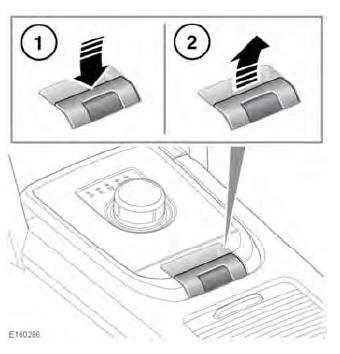Land Rover Discovery: Electric parking brake (EPB)
Do not rely on the Electric Parking Brake (EPB) to hold the vehicle stationary if the brake warning lamp is illuminated or the EPB warning lamp is flashing. Seek qualified assistance urgently
The EPB system operates on the rear wheels; therefore, secure parking of the vehicle is dependent on being on a hard and stable surface.
Do not rely on the EPB to operate effectively, if the rear wheels have been immersed in mud or water.
Note: If the vehicle is used in severe off-road conditions (e.g., wading, deep mud, etc.), extra maintenance and adjustment of the EPB will be required.
Consult a Retailer/Authorised Repairer for more information.

With the ignition switched on and the vehicle stationary:
- Press the brake pedal, then press down and release the EPB switch. This will release the EPB.
- Pull up and release the EPB switch.
This will apply the EPB. The parking brake warning lamp will illuminate to indicate that the EPB is applied.
If the system detects a fault while the EPB is operating, the red parking brake warning lamp will flash, accompanied by a warning in the Message centre.
Note: The red parking brake warning lamp will continue to be illuminated for at least 10 seconds after the ignition has been switched off.
If the system detects a fault with the EPB system, the amber brake warning lamp will illuminate accompanied by a warning in the Message centre.
If the EPB is operated when the vehicle's speed is less than 3 km/h (2 mph), the vehicle will be brought to an abrupt stop.
The stop lamps will not be illuminated.
Driving the vehicle with the EPB applied, or repeated use of the EPB to slow the vehicle, may cause serious damage to the brake system.
In an emergency, with the vehicle travelling at more than 3 km/h (2 mph), pulling up on the EPB switch and holding, gives a controlled reduction in the speed, as long as the accelerator pedal is released. The brake warning lamp will illuminate accompanied by a warning tone and a warning message in the Message centre. The stop lamps will illuminate.
Note: Automatic release of the EPB is only possible when the driver's door is fully closed or the driver's seat belt is buckled.
To delay the automatic release, hold the EPB switch in the applied position and release it at the desired point. The EPB system gradually releases to assist in a smooth drive away.
Vehicles with an automatic gearbox
The EPB is automatically applied when Park (P) is selected.
Note: To prevent this automatic operation, when the vehicle is stationary, press and hold the EPB switch in the release position. Within 5 seconds, switch off the ignition and continue to hold the EPB switch for a further 2 seconds.
If the vehicle is stationary with the EPB applied and the gearbox is engaged in Drive (D) or Reverse (R), pressing the accelerator pedal will release the EPB and allow the vehicle to move off.
Note: At the start of a journey, EPB release times may be extended when changing from P or Neutral (N). This is to allow for increased gear engagement times.
When shifting from P with the EPB applied, the EPB will automatically release to allow a smooth drive away.
Note: To prevent this automatic operation, when the vehicle is stationary, pull and hold the EPB switch in the apply position. Within 5 seconds, switch off the ignition and continue to hold the EPB switch for a further 2 seconds
Vehicles with a manual gearbox
The EPB will be applied automatically if the ignition is switched off and the vehicle's speed is below 3 km/h (2 mph).
Note: To prevent this automatic operation, when the vehicle is stationary, press and hold the EPB switch in the release position. Within 5 seconds, switch off the ignition and continue to hold the EPB switch for a further 2 seconds.
If the vehicle is stationary with the engine running and the EPB applied, pressing the accelerator pedal and releasing the clutch pedal to engage a gear, will release the EPB automatically and allow the vehicle to move off.
Note: Automatic release will only operate in first and reverse gears.
Emergency stop signal (ESS)
ESS automatically activates the hazard warning lamps during emergency braking, to warn other road users and reduce the risk of a collision.

